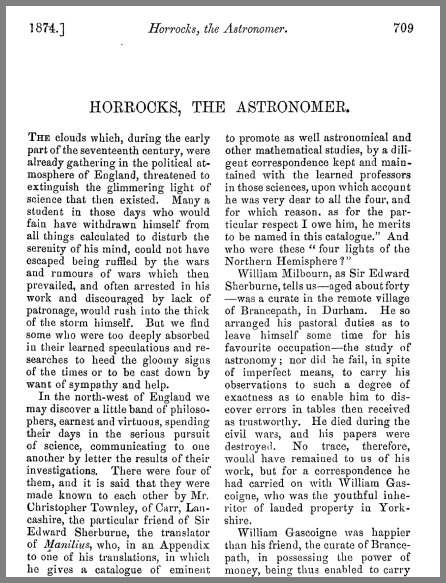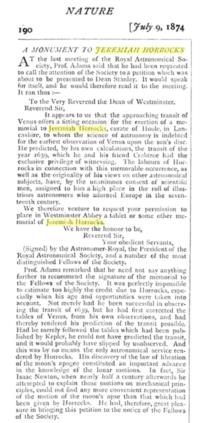
NavList:
A Community Devoted to the Preservation and Practice of Celestial Navigation and Other Methods of Traditional Wayfinding
From: Frank Reed
Date: 2023 Apr 1, 17:44 -0700
Some details on the legacy of Jeremiah Horrocks... In Google's "Ngram" viewer, it's clear that Horrocks had a burst of fame around 1874, over two centuries after his death. This makes sense because this was the year of the first Transit of Venus since 1769, and it was a perfect time to celebrate the young English astronomer who first observed a transit back in 1639. This was also when he was celebrated by a new memorial in Westminster Abbey. Details in the images below. I'm also attaching a nice biography from 1874 with an account of the events of that first observed transit of Venus.
I'm convinced (at least for the moment!) that any claims that Horrocks determined the distance to Venus or the scale of the Solar System are basically nonsense, founded on Victorian-era British nationalism. First, Horrocks did not observe anything remotely like the parallax of Venus. That was impossible. Second, the "model" that he used for his reported calculation based on the angular size of the planet was no more than guesswork, applying a completely fictional model. Third, even if we give some credit for that fictional calculation, the angular size of Venus was already known before the transit in 1639 because this was nearly three decades after Galileo (and a few years after Horrocks himself) had pointed telescopes at Venus.
None of the above should detract from the simple fact that the observation of the transit of Venus by Horrocks and Crabtree was the first in recorded history. While it is certainly conceivable, even probable, that some earlier observers may have seen Venus in transit by pinhole projection, they left no clear records of those observations.
Frank Reed










